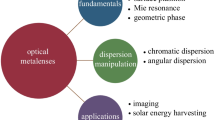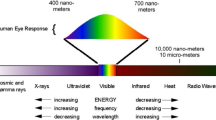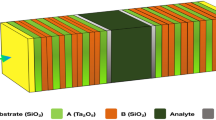Abstract
A new framework of high-selective plasmonic-induced reflectance (PIR) in a plasmonic-induced transparency (PIT) system is presented by using planar dielectric-metal-dielectric (DMD) metamaterial nano-structure. We used glass as substrate, the first dielectric, gold as metal thin film, and prism as the second dielectric. The proposed plasmonic nano-structure has been investigated based on finite difference time domain (FDTD) method. Results show that by coupling incident light with dark and bright plasmonic modes, without losing the metamaterial structure symmetry, the transparent window is created at 1550 nm and can be tuned. The transmittance (T), reflectance (R), and absorbance (A) coefficients of the presented nano-structure can be considerably varied by changing the thickness of thin films and dimension of the strips. The reflectance coefficients of dip1 (200 THz) and dip2 (265.5 THz) are almost near zero, and the transmittance coefficient of PIR (227.1 THz) is 0.93. Also, the maximum sensitivity and figure of merit are 664 and 3.77 for reflectance dip2, respectively. Similarly, the maximum quality factor (Q) is 10.74 for reflectance dip1. The presented plasmonic metamaterial nano-structure with mentioned unique features is a good candidate for several applications such as multi-channel plasmonic filters, bio and refractive index sensors, optical antenna, and slow-light devices for using in optical nano-electronic circuits and systems.













Similar content being viewed by others
References
Maier SA (2007) Plasmonics: fundamentals and applications. Springer, New York
Szunerits S, Boukherroub R (2015) Introduction to plasmonics advances and applications. CRC Press, Taylor & Francis Group, Danver
Shvets G, Tsukerman I (2012) Analysis and Applications. In: Plasmonics and plasmonic metamaterials. World Scientific, Danver
Zhang S, Genov DA, Wang Y, Liu M, and Zhang X (2008) “Plasmon-induced transparency in metamaterials,” Phys Rev Lett, 101:(4)
Vafapour Z, Forouzeshfard MR (2017) Disappearance of plasmonically induced reflectance by breaking symmetry in metamaterials. Plasmonics 12(5):1331–1342
Vafapour Z, Zakery A (2016) New approach of plasmonically induced reflectance in a planar metamaterial for plasmonic sensing applications. Plasmonics 11(2):609–618
Liu N, Weiss T, Mesch M, Langguth L, Eigenthaler U, Hirscher M, Sonnichsen C, Giessen H (2016) Planar metamaterial analogue of electromagnetically induced transparency for plasmonic sensing. Nano Lett 10(4):1103–1107
Keshavarz A, Zakery A (2017) A novel terahertz semiconductor metamaterial for slow light device and dual-band modulator applications. Plasmonics:1–8
Vafapour Z, Alaei H (2016) Subwavelength micro-antenna for achieving slow light at microwave wavelengths via electromagnetically induced transparency in 2D metamaterials. Plasmonics 12(5):1343–1352
Vafapour Z, Alaei H (2017) Achieving a high Q-factor and tunable slow-light via classical electromagnetically induced transparency (Cl-EIT) in metamaterials. Plasmonics 12(2):479–488
Vafapour Z, Zakery A (2015) New regime of plasmonically induced transparency. Plasmonics 10(6):1809–1815
Ding J, Arigong B, Ren H, Zhou M, Shao J, Lu M, Chai Y, Lin Y, Zhang H (2014) Tuneable complementary metamaterial structures based on graphene for single and multiple transparency windows. Sci Rep:1–7
Shi S, Wei Z, Lu Z, Zhang X, Li X, Liu H, Liang R (2015) Enhanced plasmonic band-pass filter with symmetric dual side-coupled nanodisk resonators. J Appl Phys 118(14)
Gao X, Zhou L, Cui TJ (2015) Odd-mode surface plasmon polaritons supported by complementary plasmonic metamaterial. Sci Rep:1–5
Mahani FF, Mokhtari A, Mehran M (2017) Dual mode operation, highly selective nanohole array-based plasmonic colour filters. Nanotechnology:1–9
Keleshtery MH, Mir A, Kaatuzian H (2017) Investigating the characteristics of a double circular ring resonators slow light device based on the plasmonics-induced transparency coupled with metal-dielectric-metal waveguide system. Plasmonics:1–12
Xia F, Sekaric L, Vlasov Y (2006) Ultracompact optical buffers on a silicon chip. Nat Photonics:65–71
Chen N, Pitchappa P, Ho CP, Hasan D, Kropelnicki P, Alioto M, Lee C (2016) Polarization controllable multispectral symmetry-breaking absorber in mid-infrared. J Appl Phys 120(6):063105–063108
Chen X and Fan W (2017) “Ultrasensitive terahertz metamaterial sensor based on spoof surface plasmon,” Scientific Reports, pp. 1–8
Farmani A, Zarifkar A, Sheikhi MH, Miri M (Dec. 2017) Design of a tunable graphene plasmonic-on-white graphene switch at infrared range. Superlattice Microst 112:404–414
Xu M, Li F, Wang T, Wu J, Lu L, Zhou L, Su Y (2013) Design of an electro-optic modulator based on a silicon-plasmonic hybrid phase shifter. J Of Lightwave Technol 31(8):1170–1177
Hatta AM, Kamli AA, Al-Hagan OA, Moiseev SA (2015) Slow light with electromagnetically induced transparency in optical fibre. J Phys B: Atomic Mol Opt Phys 48(7):15502
Yang J, Yang S, Song X, Wu F and Yu L (2017) “Active control of slow light in a gain-assisted plasmon-induced transparency structure,” IEEE Photonics J, 9
Neveu P, Maynard MA, Bouchez R, Lugani J, Ghosh R, Bretenaker F, Goldfarb F, and Brion E (2017) “Coherent population oscillation-based light storage,” Phys Rev Lett, 118
Wang X, Zhou P, Wang X, Xiao H, and Liu Z (2015) “Tunable slow light via stimulated Brillouin scattering at 2 μm based on Tm-doped fiber amplifiers,” Opt Lett , 40(11)
Liang JQ, Katsuragawa M, Kien FL, and Hakuta K (2002) “Slow light produced by stimulated Raman scattering in solid hydrogen,” Phys Rev A, 65
Ye Y, Xie Y, Liu Y, Wang S, Zhang J, Liu Y (2017) Design of a compact logic device based on plasmon-induced transparency. IEEE Photonics Technology Let 29(8):647–650
Prabhathan1 P, Murukeshan VM (2016) Surface plasmon polariton-coupled waveguide back reflector in thin-film silicon solar cell. Plasmonics 11(1):253–260
Ji L, Sun X, He G, Liu Y, Wang X, Yi Y, Chen C, Wang F, Zhang D (2017) Surface plasmon resonance refractive index sensor based on ultraviolet bleached polymer waveguide. Sensors Actuators B Chem 244:373–379
H-J Li, X. Zhai, R. Wujiaihemaiti, L-L W. and X-F. Li, “Tunable optical filters and multichannel switches based on MIM plasmonic nanodisk resonators inset a silver bar” IOP. Physica Scripta, 90:015604(6pp), 2014
Keleshtery MH, Kaatuzian H, Mir A, Zandi A (2017) Method proposing a slow light ring resonatorstructure coupled with a metal–dielectric– metal waveguide system based on plasmonic induced transparency. Applied Optics 56(15):4496–4504
Liang Y, Zhang S, Cao X, Lu Y, Xu T (Jun. 2017) Free-standing plasmonic metal-dielectric-metal bandpass filter with high transmission efficiency. Sci Rep:1–8
Han X, Wang T, Li X, Liu B, He Y, Tang J (2015) Dynamically tunable slow light based on plasmon induced transparency in disk resonators coupled MDM waveguide system. J Phys D: Appl Phys 48:235102(10pp
Vafapour Z (Mar. 2017) Near infrared biosensor based on classical electromagnetically induced reflectance (Cl-EIR) in a planar complementary metamaterial. Opt Commun 387:1–11
Wei Z, Li X, Zhong N, Tan X, Zhang X, Liu H, Meng H, Liang R (2017) Analogue electromagnetically induced transparency based on low-loss metamaterial and its application in nanosensor and slow-light device. Plasmonics 12(3):641–647
Wu J, Jin B, Wan J, Liang L, Zhang Y, Jia T, Cao C, Kang L, Xu W, Chen J, Wu P (2011) Superconducting terahertz metamaterials mimicking electromagnetically induced transparency. Appl Phys Lett 99(16):161113(3)
Author information
Authors and Affiliations
Corresponding author
Rights and permissions
About this article
Cite this article
Alipour, A.H., Mir, A. Design and Simulation of a High-Selective Plasmon-Induced Reflectance in Coupled Dielectric-Metal-Dielectric Nano-structure for Senor Devices and Slow Light Propagation. Plasmonics 14, 511–521 (2019). https://doi.org/10.1007/s11468-018-0829-9
Received:
Accepted:
Published:
Issue Date:
DOI: https://doi.org/10.1007/s11468-018-0829-9




